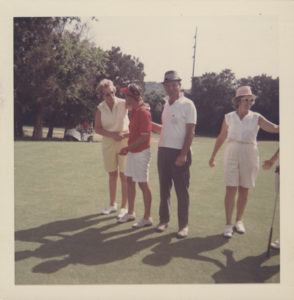All Eyes on Muny

Lions is an 18-hole golf course that spans 141 acres just west of downtown along Lake Austin Boulevard. Those who golf at Lions say they appreciate its setting, atmosphere and nearly 100-year history.
The course sits on land owned by The University of Texas but is operated by the City of Austin. The city leases the golf course property from the University.
Lions’ current lease is set to expire in May 2020, and with ongoing discussions taking place between the City and University regarding its future, it’s unclear what lies ahead for the course.
“We’re in the dark,” says Erik Lopez, manager and head golf instructor at Lions. “Anytime you’re working with state and city — it seems like we probably won’t know much until the very end.”
The UT System’s Board of Regents has previously contemplated leasing the Lions property for commercial and residential development once the course’s lease ends. This has led many Austinites familiar with the course to become passionate about its preservation.
Most recently, the University has said it is working toward finding a solution that continues to use the land Lions sits on as a golf course. But during this in-between period for the course, nothing is certain.
A Bit About Lions
The Lions course, more affectionately called Muny, is part of the Brackenridge Tract — 350 acres of land donated to the University in 1910. The Lions Club leased a part of the tract from the University in 1924 and converted it into a public golf course. In 1936, that lease was transferred to the city.
Muny is recognized as the first municipal course south of the Mason-Dixon Line to be desegregated and was added to the National Register of Historic Places in 2016.
It is the most popular municipal course in Austin, says Lopez.

Understanding the Issue
The UT System’s Board of Regents, the System’s governing body, has for years contemplated leasing the Muny property for residential and commercial development, according to the Austin-American Statesman.
The University’s agreement to lease Muny to the city has been extended over the years. In 2011, the Board voted against renewing the city’s lease when it expired in May 2019.
At the time of that vote, the Board said that revenue from leasing the land for commercial and residential development would benefit the University’s Austin campus, the Statesman reported.
However, much has changed in the years since 2011. The University decided in February of this year to extend the city’s lease again, to May 2020.
UT spokesperson J.B. Bird said in an email that the University aims to “come up with a plan that is mutually beneficial to the city and UT and that continues to use the Muny tract as a golf course.” In May, the University offered to sell the course to the city for $110 million.
Where That Leaves the Course Today
What will happen to Muny remains to be seen. Alison Alter, City Council Member for District 10, which includes Muny, said in an email that the city is in active negotiations with the University to preserve the land used for the course for future generations.
Alter says saving the public space has been one of her top priorities since she took office.
“In my mind, the negotiations are not simply a real estate transaction, but involve choices that profoundly affect our cityscape, our ability to preserve our history and our access to beautiful open spaces in the decades to come,” Alter says.
The city currently leases the golf course property for around $500,000 a year, according to the Statesman. In 2018, UT President Greg Fenves told the newspaper that he puts the fair market lease value of Muny at about $6 million a year.
Alter could not comment to AFM on how the city was considering the $110 million sell offer from the University, as city and University negotiations are still ongoing.
Lopez, who has worked at Muny for seven years, says he thinks the University would prefer to get a certain value out of the Muny property and preserve the course, rather than develop it. However, he also expressed the University’s current selling price of Muny to the city is steep.
“That’s a lot of money to fork over for a golf course,” he says.

Efforts to “Save Muny”
There are multiple initiatives currently aiming to help preserve the course, including Save Muny, a grassroots organization that started in 1973 and reformed around the time the University voted to end Muny’s lease in 2011.
Save Muny has advocated for the course’s preservation and kept news surrounding the course’s status in front of the public over that time.
Save Muny member Steve Wiener says that for many years, the group talked to both UT and the city looking for a solution that would preserve the course, but the City of Austin’s capabilities of doing that have been limited.
He says he thinks that at this point, the best way to preserve the course would be for a group of people, a conservancy or other entity, to buy the course from UT.
“That way they’ve taken care of their financial responsibilities of being stewards of that land,” says Wiener, who is also involved with the Muny Conservancy, a group that intends to purchase the course from the University and continue to run it as a golf course.
A Community Conversation
Many members of the Austin community would like to see the course preserved. Among them is Bill Kasza, who’s played at Lions since the 80s.
Kasza says he’s become very familiar with the course over the years, and he knows others who have played at Muny for much longer.
“There are 80-year-old men who have been coming out here since they were a child,” he says. “It’s more than a golf course to the golfers.”
Similar perspectives aren’t hard to find.
“It’s a staple of Austin,” says Texas State student Emmitt Ousey, who has played on the course since high school. “I think if this was something else, you wouldn’t get the benefit that this course has right now.”
Dede Hurson, a newcomer to Muny, also wants to see the course preserved. She picked up golf about two months ago and says she likes the atmosphere that a public course provides.
“It’s not like a country club atmosphere,” Hurson says. “It’s more laid back and relaxed.”
Wiener says the course is short, challenging and very beautiful. He thinks there are many things that make the course special, from its setting and history to its affordability.
”Overall, you get a great feeling when you’re there on that property, and you get the feeling that it would be a travesty to lose that golf course,” he says.
These are not the only conversations about the course taking place, however. Other Austinites argue there could be better uses for the land the course sits on.

Austin resident Jack Craver says Austin is in a housing crisis, and that the city needs affordable housing and market rate housing more than it needs a municipal golf course.
“It’s very hard for people of modest means, for low income people, for middle class people to afford to live in Austin,” Craver says. “We need to be able to provide housing for as many people as possible.”
Craver, who runs a newsletter about Austin politics, says exclusionary zoning laws in many central neighborhoods and West Austin neighborhoods prevent the type of housing that is accessible to people of low, moderate and middle incomes.
“If we’re ever going to become a more integrated city that is accessible to people of different levels of incomes, when we have a piece of property like that, we need to take advantage of it and put housing there,” Craver says.
Morris Green grew up playing golf at Muny. Now a real estate agent, he says he understands arguments both for and against the course’s preservation.
However, he says that he thinks the land the course is on could serve a better purpose than just housing the golf course — whether it’s instead used for affordable housing, public parkland or to benefit students at the University.
“I just don’t think it needs to be an 18-hole golf course,” Green says. “It needs to be open to change and adapting to what our city needs now.”
Until more is known about the future of Lions, deliberations will continue.






